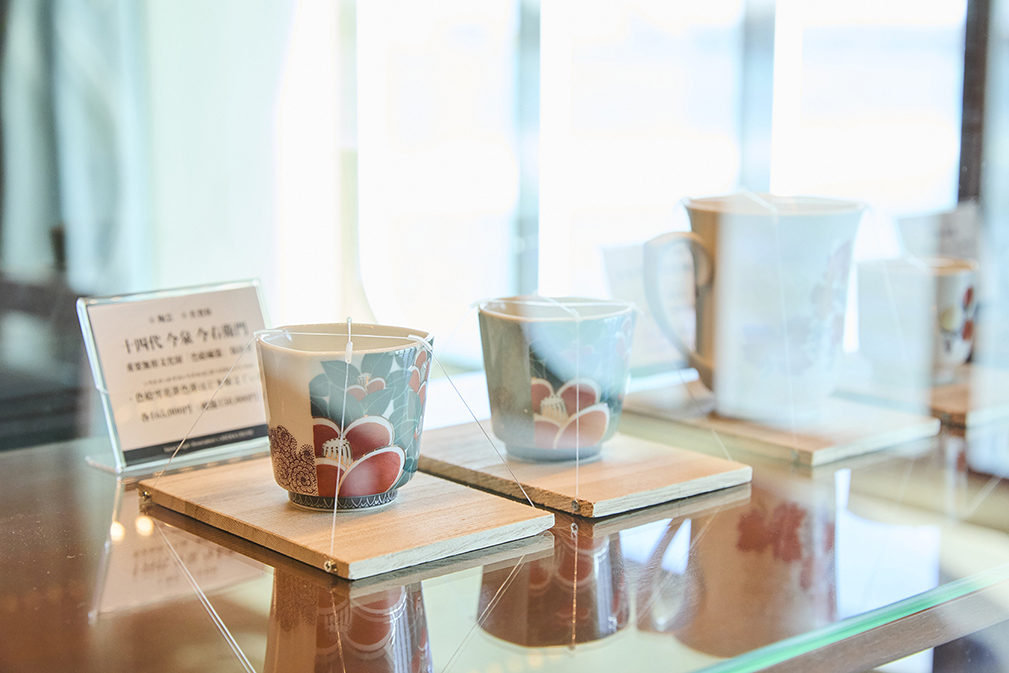Continuing to Nurture a Bond That Is Part of Our Legacy
A member of the NYK Group, NYK Cruises Co., Ltd., runs ASUKA CRUISE, which refers to the cruise business that operates ships bearing the ASUKA name. The company operated ASUKA between 1991 and 2006. Thereafter, the company ceased service of ASUKA and commenced operations of ASUKA Ⅱ. The company’s cruise business is operated in line with the brand statement: “We want to enable moving experiences through cruises that provide encounters with the real thing.” In December 2021, NYK Cruises marked the 30th anniversary of ASUKA CRUISE by beginning a collaboration with the Japan Kōgei Association* (“Kōgei” is Japanese for “art crafts.”). As well as using ASUKA Ⅱ to exhibit and sell the traditional Kōgei of artists who have been designated as living national treasures, the company offers experiences unique to ASUKA CRUISE, such as talks by living national treasures and tours of workshops in ports of call.
NYK’s involvement with traditional Japanese Kōgei dates back to 1928. The maki-e (Japanese urushi* sprinkled with gold or silver powder) of Gonroku Matsuda, who was a living national treasure, was displayed on an NYK cruise ship built in that year. The elegance of his work attracted a great deal of attention, particularly overseas. The magnitude of the response to the maki-e renewed NYK’s appreciation of the magnificence of traditional Japanese Kōgei.
As the chief branding officer of NYK Cruises, Sachio Takahashi has been in charge of the collaboration with the Japan Kōgei Association since the initial planning stages. He explains the Group’s strong links with traditional Japanese Kōgei.
“Kazumi Murose, who is the vice president of the Japan Kōgei Association and a protégé of Gonroku Matsuda, has been instrumental in making this collaboration possible. I feel that the NYK Group has established a strong bond with traditional Japanese Kōgei. It is impressive that ASUKA Ⅱ is continuing the Group’s history in this way and that the legacy will be passed on to ASUKA Ⅲ.”
An array of traditional Kōgei is being prepared to delight the passengers of ASUKA Ⅲ, a new cruise ship scheduled to enter into service in 2025.
Creating Value Based on Cruises That Provide Encounters with the Real Thing
Why is NYK Cruises strongly committed to providing “encounters with the real thing”?
The answer is that crew members want to widely share the moving experiences they often have while working on cruise ships. As well as moving experiences resulting from cruises that provide encounters with the “real thing,” crew members are familiar with the emotions engendered by extraordinary times and places that lead to encounters with nature’s beauty, marine life, people at ports of call, and new selves.
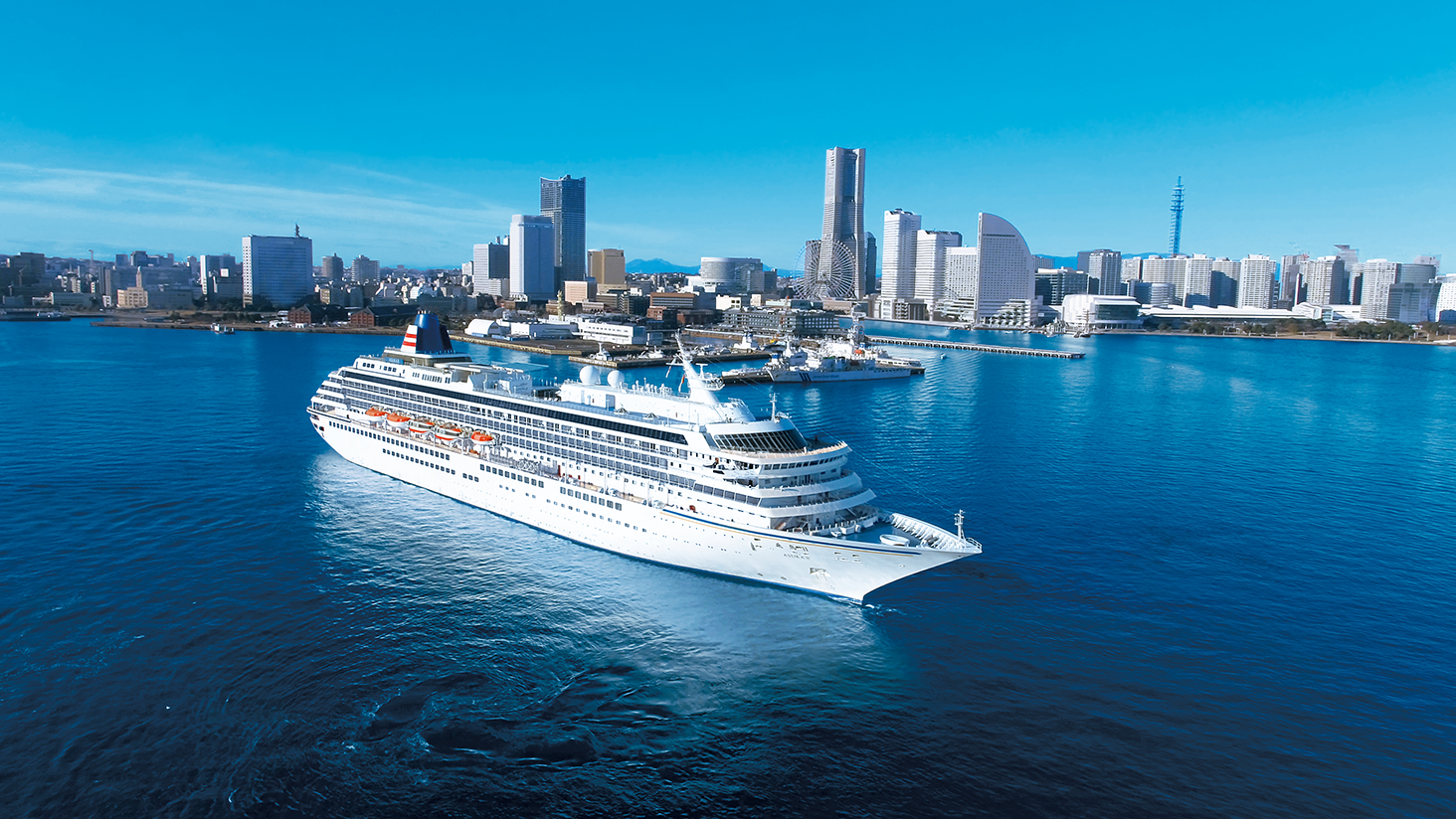
Satoru Yoshida, who is the general manager of NYK Cruises’ Hotel Division, is clearly passionate about providing customers with moving experiences.
“I believe some of our customers have disembarked at ports they would otherwise never have had the chance to visit had they not taken a cruise onboard ASUKA Ⅱ. When we arrive at ports, the local people are extremely welcoming. At each port of call, they are happy to introduce us to the unique regional cultures and traditions that comprise their heritage. Customers who disembark are able to enjoy experiences available only in those regions. I believe one of our missions is to use cruises to realize and cherish encounters between customers and local communities. We are constantly thinking about what we can do to deliver moving experiences that exceed customer expectations.”
ASUKA CRUISE also offers cruises themed on traditional Japanese performing arts that have gained renown, such as sumo, Bunraku, and Kabuki. We have curated all of these cruises in partnership with the originators of each performing art, gaining endorsement from the Japan Sumo Association for sumo and from the Bunraku Kyokai for Bunraku. Yoshida explains that cruises are well suited to enjoyment of the arts.
“Our cruises allow customers to experience Japanese culture in an atmosphere that is more relaxed than usual. I also believe the cruises can play a significant role in passing on Japanese culture.”
Similarly aware of the importance of passing on Japan’s cultural legacy, Takahashi understands the interrelationship between traditional Kōgei and traditional performing arts and appreciates the significance of realizing it on board the cruise ships of ASUKA CRUISE.
“Traditional Kōgei and traditional performing arts resemble two wheels of a vehicle. The tools used in traditional performing arts cannot be maintained unless traditional Kōgei survive. Conversely, traditional Kōgei cannot prosper without the continuance of traditional performing arts.”
Reika Nemoto, who worked as a shop manager and was in charge of selling traditional Kōgei on board ASUKA Ⅱ, recalls one conversation with an artist that left a lasting impression on her.
“An artist who boarded the ship told me that she viewed each piece of Kōgei Art (Kōgei craftwork) as if it were her own child. As a parent, she is very proud and happy that, after leaving the hands of its creator, her child is traveling around the world on board a ship and being exhibited in a special space. I feel that our collaborations are helping the activities of artists by providing more opportunities for many different people to see their works.”
As Takahashi says, the continued commitment of ASUKA CRUISE to cruises that provide encounters with “the real thing” and to supporting both “wheels” of traditional culture creates value in terms of preserving such culture. As Yoshida mentions, value is also created by encouraging lively activity at ports of call.
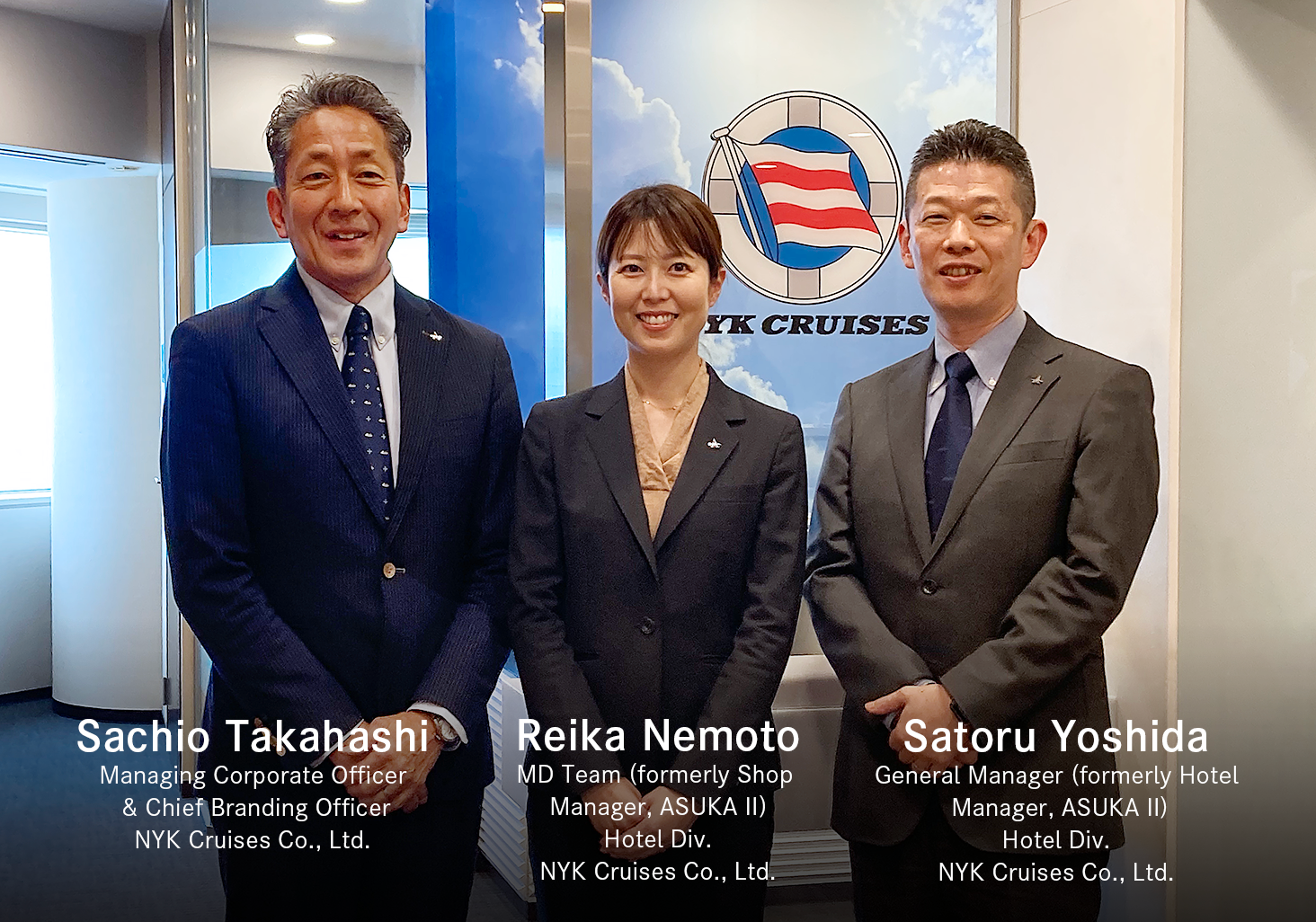
Delivering Value through Crew Members Who Are Focused on “Encounters”
Our onboard exhibitions are designed to minimize the effects of the ship’s motion and ultraviolet rays, thereby allowing customers to appreciate the beauty of the works as they are. The methodically planned installation of the works was the product of a process of trial and error that combined the accumulated onboard experience of NYK Cruises with the Japan Kōgei Association’s experience in handling artworks. The ship’s highly attractive displays of approximately 140 traditional Kōgei Arts are a testament to the efforts of crew members to give customers encounters with “the real thing” while at sea.
Nemoto remembers receiving Kōgei artworks and preparing for their display.
“Before the onboard exhibition, only basic information accompanied each piece of Kōgei Arts we received. After receiving them, shop personnel researched the characteristics and background of each piece.”
Nemoto explains that the shop personnel filed the information they compiled and shared it with each other. Moreover, rather than confining the sharing of this knowledge to the shop team, they provided tours of the traditional Kōgei for other crew members.
“Kōgei Arts is displayed in the dining room, reception area, and other areas of the ship. We conducted tours of the ship for crew members with the aim of enabling not only shop personnel but all crew members to convey the appeal of the traditional Kōgei to customers. A great deal of knowledge is required to fully explain Kōgei Arts. Nonetheless, I feel that throughout ASUKA Ⅱ we have been able to create and welcome customers into a refined atmosphere that is heightened by the presence of traditional Kōgei.”
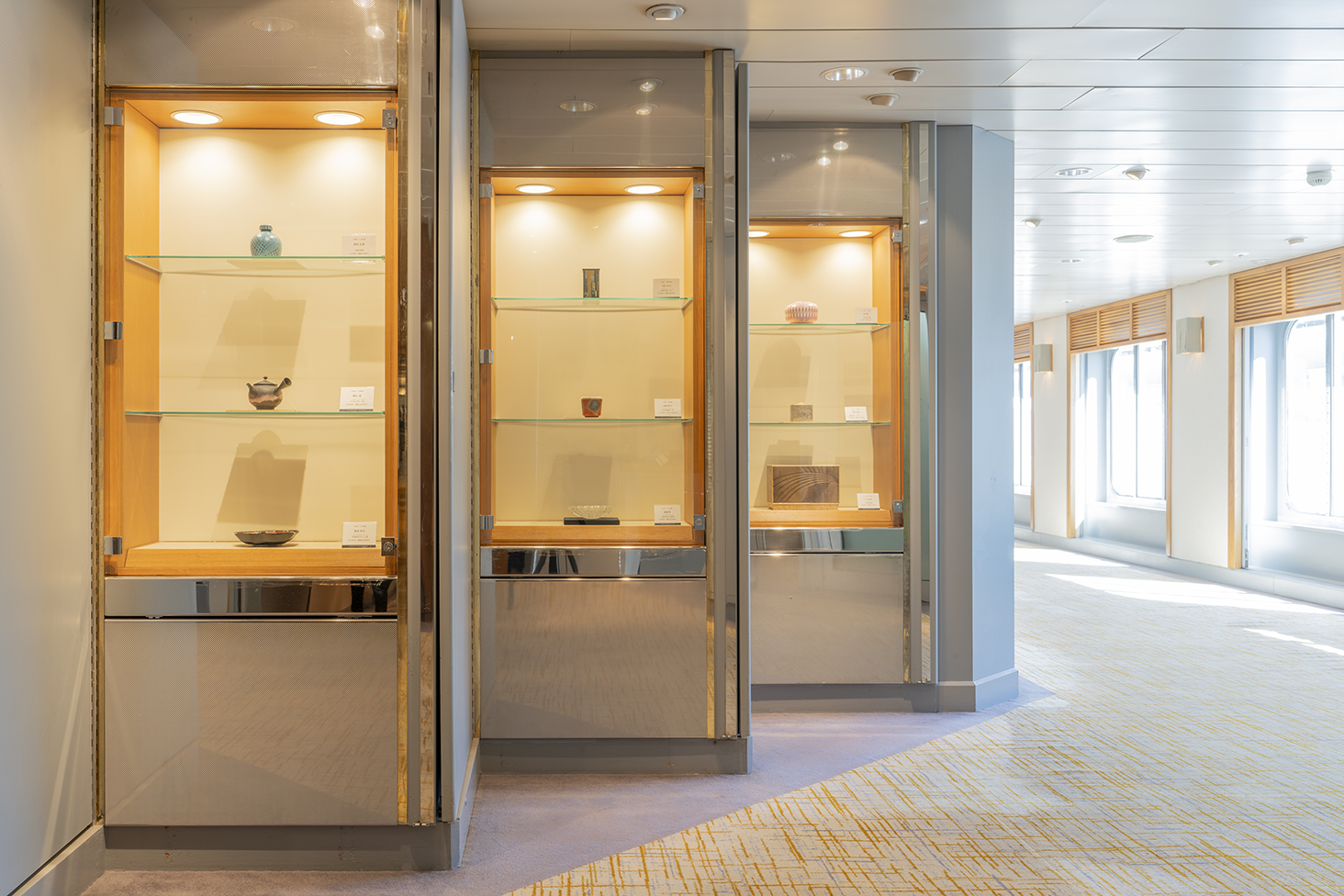
Developing an in-depth understanding of artists’ intentions and being able to confidently explain them to customers are tasks that as a sales professional Nemoto has focused on since joining the company.
In fact, recently increasing numbers of passengers are returning to the ship because, as well as being attracted by crew members, the onboard atmosphere, and the travel of cruises, they want to repeat the experience of viewing and purchasing traditional Kōgei on board. Yoshida describes this as customers coming to “meet” Kōgei Arts.
Japanese has an expression that means “beauty in use.” Traditional Japanese Kōgei have an appeal that cannot be appreciated through viewing alone, but which becomes apparent through their day-to-day use. Using Kōgei Arts gives a tangible sense of the artist’s painstaking workmanship. On board ASUKA Ⅱ, we encourage passengers to handle Kōgei Arts when they are considering making a purchase. At the same time, we explain that artists want their Kōgei Arts to be used.
Nemoto views herself “a spokesperson for artists.” As artists work in their studios on many delicate processes, they keep in mind that someday someone will hold Kōgei Art in their hands. Nemoto elaborates on her feelings in this regard.
“I want to cherish the passion of artists as well as the moving experiences customers have when they encounter a piece of Kōgei Art.”
Thus, ASUKA Ⅱ is acting as a sympathetic link between the sensibilities of traditional art craftspeople and passengers.
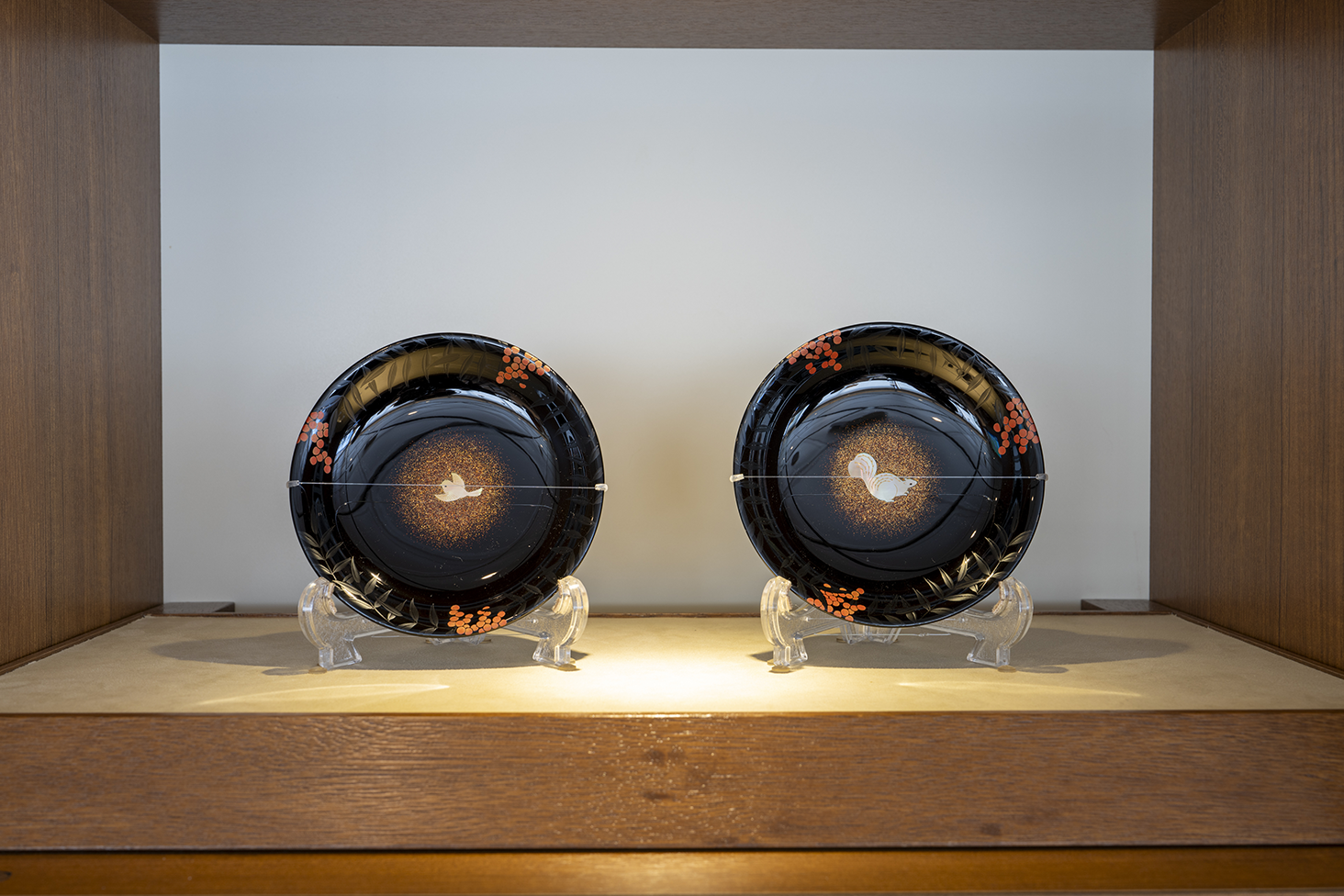
Creating a Future That Combines Tradition with New Initiatives
In 2023, the second year of collaboration between ASUKA CRUISE and the Japan Kōgei Association, the Japan Kōgei Association Member and ASUKA CRUISE Award was established. Three artists were selected to receive the inaugural award, and an award ceremony and talks were held onboard ASUKA Ⅱ. The event helped bring the Kōgei Arts of promising artists to the attention of a wider audience.
Takahashi hopes that the establishment of the award and future voyages of ASUKA Ⅲ will support the activities of the young artists who inherit Japan’s traditions. If only the preservation of “the good old things” is emphasized, traditions eventually die out. Truly carrying on traditional culture requires the careful nurturing of new elements that can flourish amid tradition.
ASUKA Ⅲ has been designed based on the concept of a “mobile offshore museum.” To create a venue that invigorates various types of art, the ship’s collection will extend beyond traditional Kōgei and showcase art from a range of genres. Moreover, we will take on the challenge of asking the public to submit works of art for display. Takahashi is clearly passionate about displaying works of art.
“I aim to enable passengers on board our ships to see, touch, and experience the most beautiful works of art. Our approach is not to assume that our pieces of art must be unrivaled because they are the most prominent in their genre. Instead, we are committed to presenting items that we genuinely believe to be good. By doing so, we want to provide our customers with opportunities to have all kinds of new encounters.”
What constitutes “the real thing” is not determined by crew members but by the sensibilities of each passenger who has an encounter. Almost everyone has had an unexpected encounter that seems to instantly color their life. Cruises that provide encounters with “the real thing” are what ASUKA CRUISE aims to deliver. Such encounters are based on the unforgettably moving experience of coming into contact with breathtaking scenery, the warmth of the people of the ports of call, local cultures, and the passion that creators of traditional Japanese culture devote to their work.
ASUKA CRUISE brings joy and value to everyone involved in its operations. The accumulation of moving experiences on board our cruise ships will forge emotional ties that encourage the creation and nurturing of even more new value.
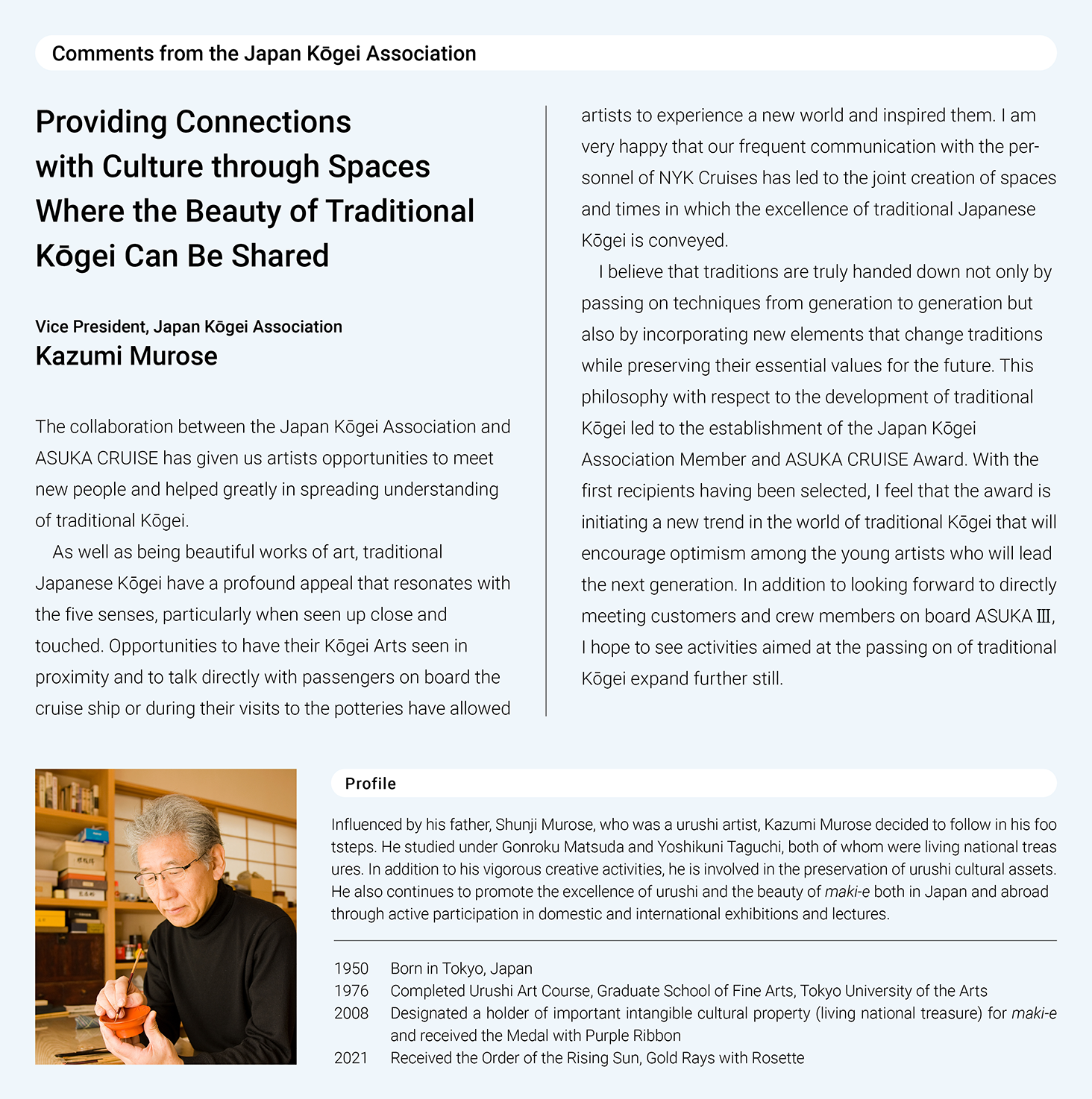
(Interview February 20, 2024)
- * Japan Kōgei Association
An organization of traditional Kōgei artists that is led by holders of important intangible cultural property (living national treasures) - * urushi
Urushi refers to the traditional Japanese lacquer made from the sap of the urushi tree





